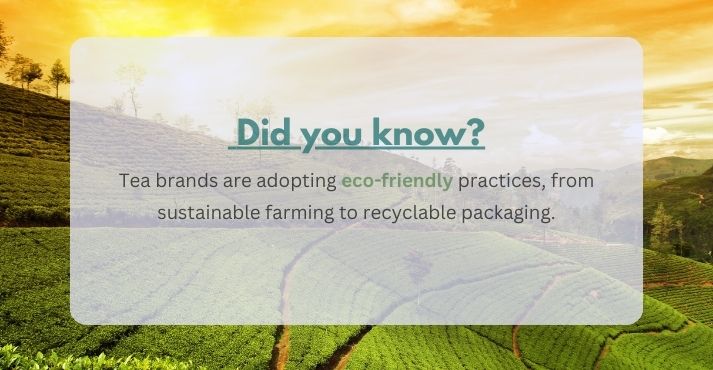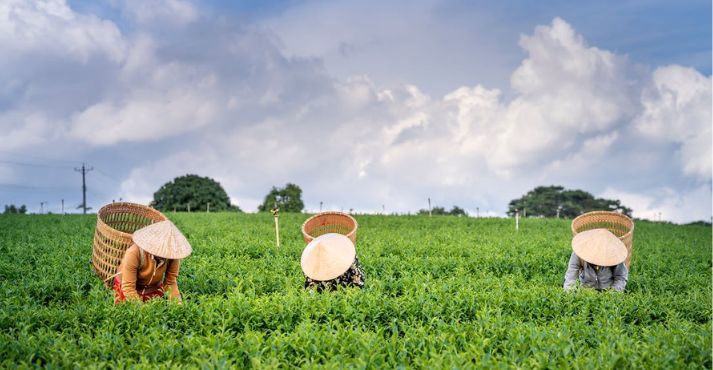Tea is one of the most commonly consumed beverages in the world.
Generation after generation, tea has reshaped itself with the evolving needs of consumers.
The market is experiencing rapid growth due to trends associated with health benefits and increased awareness in the tea sector.
Tea brands face unique trends, focusing on consumers willing to experiment with more flavors due to increasing awareness and wellness. With that in mind, you need to keep an idea of the critical tea consumption trends worldwide.
Tea Market Global Key Insights

Today, the global tea industry’s worth is around US$11.42bn in 2024 and is expected to rise to US$18.68bn by 2029. The tea sector is undergoing significant transformations driven by emerging trends reshaping the industry landscape.
2022, global tea consumption amounted to about 6.7 billion kilograms and is estimated to reach 7.4 billion kilograms by 2025.
With consumers increasingly seeking healthier beverage options, the demand for herbal and specialty teas has surged, propelling the tea industry’s worth to new heights.
The consumption of tea by consumers is on an upward trajectory, making it a staple in the daily routines of individuals seeking both physical and mental well-being.
Moreover, the increase in awareness of carbonated drinks and health issues faced by consumers worldwide has changed the tea market through:
- Acceptance of ethnic aspects has led to a broader range of tea options.
- Increase in health-conscious consumers, such as green tea for weight management or herbal teas for relaxation and digestion.
- Awareness of adverse health effects of carbonated soft drinks.
- Tea bags have revolutionized tea consumption by providing a convenient and mess-free way to brew tea.
The dynamic of the tea sector is continuously evolving; the tea trends are poised for sustained growth and adaptation to meet the ever-changing demands of consumers worldwide.
5 Key Tea Consumptions Trends
Let’s examine the 5 key consumption trends transforming the tea sector landscape.
1. Growing Trend of Herbal Teas
As the U.S. wellness market continues to boom, a pattern of interest and growth can be seen in health and wellness. According to Future Market Insights, the global herbal tea market is projected to be valued at US$ 3,962.7 million by the end of 2023.
As a direct consequence of fat-burning properties, herbal teas are attributed to increasing health benefits that align with the shifting consumer demands.
2. Surging Interest in Functional teas
Tea companies are responding to the growing demand for functional teas with new flavors driven by innovative upstarts. The functional tea market targets a new generation of healthy and active consumers and appeals to non-tea drinkers through its evident health benefits.
Functional teas target a new demographic seeking a natural energy kick, seeing gains from this consumer shift. Green tea and turmeric tea are two commonly used functional teas worldwide.
3. Booming Market for Matcha Tea
The Global Matcha Tea Market size is expected to reach $3.8 billion by 2028, rising at a market growth of 6.6% CAGR during 2023-2028.
The rise of matcha tea is propelled by increased tea consumers adopting healthy lifestyles and looking for health advantages. As matcha tea is made by harvesting and crushing young tea leaves into a beautiful green powder, it helps you boost metabolism, increase energy levels, and improve mental clarity.
4. Increasing Demand for Loose-Leaf Tea
Tea consumers are becoming more interested in loose-leaf tea. With intense flavor, distinct taste, and freedom to blend mixes, loose-leaf tea has more nutritional potency and produces a more robust flavor and authentic tea experience.
While inflation of consumer prices remains at an elevated level, consumer purchase behavior is evolving. Tea consumers prefer private-label products such as loose-tea leaf over branded products.
5. Growing Commitment to Sustainability
According to a study conducted by McKinsey and NeilsenIQ, there’s a clear and substantive correlation between consumer spending and sustainability-related claims. Consumers in the tea sector are also shifting their spending toward products with environmental safety-related claims.
Therefore, a product label that represents authentic and meaningful information on social action fulfills the moral imperative demanded by the consumers.
Tea Market Segmentation

Tea market segmentation occurs based on form, distribution channel, and geographical location. It refers to the process of dividing your target market into approachable groups. It can be based on their demographics, needs, priorities, shared interests, and other psychographic or behavioral factors.
Players in the tea sector can benefit from market segmentation by prioritizing the most profitable and loyal segment, creating relevant products, and boosting sales. Also, segmentation enables tea companies to unlock new opportunities and niches in the market.
Consumer Buying Behavior Affecting Distribution Channels in the Tea Sector
The tea sector can also be segmented based on distribution channels, such as supermarkets, specialty stores, convenience stores, and e-commerce stores. Each distribution channel caters to different customer segments in the tea sector.
Consumer purchasing behavior profoundly influences the distribution network within the tea market. Consumers seek convenience, choice, and information, driving companies to expand their online presence.
E-commerce dominance
Online stores have gained popularity during the pandemic. Consumers appreciate the convenience, variety, and detailed product information available online.
Online stores offer tea varieties, including loose-leaf, bagged, and specialty teas, with customer reviews and ratings that assist new buyers in making informed decisions.
Specialty Tea Stores
Consumers seeking unique and premium teas have spurred the growth of specialty tea shops. These specialty tea stores offer a curated selection and personalized experiences, attracting tea connoisseurs.
Health-Focused Retailers
Health-conscious buyers have driven the expansion of health food stores as distribution points for specialty and wellness teas. These retailers cater to consumers looking for teas with specific health benefits.
Convenience Stores and Supermarkets
One of the most important distribution channels, supermarkets make it convenient for consumers to purchase alongside other items. Mainstream consumers still rely on convenience stores and supermarkets for their tea purchases. Brands adapt by offering various options to cater to diverse tastes.
Geographical Frontiers in the Tea Sector
Global tea sector growth is driven by consumers worldwide, mainly from North America, Europe, Asia Pacific, South America, the Middle East, and Africa. Increasing awareness about tea’s health benefits, cafe culture, changes in taste preferences, weather, and other factors have driven the growth of tea in different geographies.
North America
The Tea market in North America is projected to grow by 3.19% (2023-2028), resulting in a market volume of US$3.8bn in 2028.
In this region, the tea sector exhibits a growing preference for herbal and specialty teas, emphasizing health-conscious consumption and innovative tea blends.
Europe
Tea culture is deeply rooted in the culture of Europe, and the tea sector growth is projected to increase by 5.75% (2023-2028), resulting in a market volume of US$15.1 billion in 2028.
Consumers in this region prefer traditional black tea varieties and herbal infusions, with a growing interest in specialty teas.
Asia Pacific
The tea market is projected to grow at a rate of 5.13% (2023-2028), resulting in a market volume of US$105.9 billion in 2028.
Asia Pacific is the birthplace of tea with a rich tea heritage. Asia Pacific is known for green tea consumption, especially in countries like China and Japan.
South America
The Tea market in South America is projected to grow by 4.70% (2023-2028), resulting in a market volume of US$12.0bn in 2028.
South America is experiencing a shift toward tea, with countries like Argentina embracing yerba mate. Herbal teas and exotic blends are gaining popularity.
Middle East
The Tea market in the United Arab Emirates is projected to grow by 0.53% (2023-2028), resulting in a market volume of US$102.1m in 2028.
The Middle East appreciates strong, spiced teas like chai and traditional herbal remedies. Tea is an integral part of social and cultural gatherings.
Africa
The Tea market in Africa is projected to grow by 11.15% (2023-2028), resulting in a market volume of US$21.7bn in 2028.
Africa has a burgeoning tea sector, with countries like Kenya being major tea producers. Both traditional and flavored teas are consumed, reflecting cultural diversity.
Competitive Tea Industry Landscape
Tea consumption has existed since 1500 BC, and thousands of tea varieties exist, mainly black, green, white, and oolong. Competition in any industry is driven by factors influencing how companies vie for market share and customer attention.
Some of these key factors include:
- Changing consumer preferences
- Quality and taste of tea products
- Competitive pricing and value propositions
- Branding and marketing campaigns
- Accessibility through various channels
- Innovation in new flavors, blends, or brewing methods
- Environmentally friendly and ethical sourcing methods
- Access to diverse tea sources
- Health and wellness trends
- Technology and online presence
- Customer experience
- Industry consolidation through mergers and acquisitions
- Economic conditions, currency fluctuations, and trade policies
- Cultural and regional factors
Established companies continue to dominate the mass-market segment, offering a wide range of traditional and flavored teas. Meanwhile, specialty and organic tea producers have gained popularity among health-conscious consumers.
Some of the most prominent players in the tea sector are:
- The Republic of Tea
- Tetley
- Harney & Sons
- Lipton
- Celestial Seasonings
- Yorkshire Tea
- Bigelow Tea Company
- Clipper tea
- Brooke Bond
Future Developments in the Tea Sector

As the global tea sector is booming, several vital developments are redefining the industry. Even though the economies fluctuate today, the tea demand is growing.
While the industry faces several key challenges, significant developments are occurring in the tea sector.
Wellness Teas
Wellness teas were already on the rise before the pandemic, and today, more health-conscious consumers have shifted toward this option. Consumers have realized the need for immunity-boosting beverages, such as Kombucha green tea and other wellness teas. Customization is gaining popularity, with companies offering personalized wellness blends and subscription services, allowing consumers to tailor their tea experience.
Premium Tea
Premium tea is a burgeoning trend in the tea sector, driven by consumers’ willingness to invest in higher-quality, unique tea experiences. Consumers are seeking an elevated experience through flavors and aromas.
Eco-Friendly Packaging
Companies have continued to incorporate sustainability in the tea industry. Through initiatives such as recyclable, biodegradable, and compostable materials for tea bags, boxes, and wrappers, tea companies can reduce their environmental footprint through eco-friendly packaging.
Trends in the Tea Sector – FAQs
How much is the tea market worth?
The global tea market was valued at around US$11.42bn in 2024 and is expected to rise to US$18.68bn by 2029.
What is the growth rate of the tea market?
As the consumption trend in the tea sector continues to grow, the global tea market is expected to grow annually by 10.34% CAGR 2024-2029.
What are the key trends affecting the tea market?
Key trends affecting the tea market:
- Specialty and artisanal tea offerings
- Health and wellness consciousness
- Sustainability and ethical sourcing
- Innovative tea formats and flavors
- E-commerce and online tea purchases
What is the primary market restraint?
Major market restaurants in the tea sector are:
-
- Climate change and weather variability
- Fluctuating tea prices
- Regulatory challenges
- Competition from other beverages
- Labor shortages
Who is the biggest consumer of the tea market?
China has, by far, the largest tea market worldwide, valued at over 91 billion U.S. dollars.
Conclusion
As we analyzed the consumption patterns, market segmentation, and trends in the tea sector, it is evident that the sector is ever-evolving. Driven by consumer interest, health-conscious preferences, and ethnic aspects, tea is leading to a broader market.
Health remains dominant, with tea’s natural components like flavonoids and antioxidants gaining recognition for their myriad health benefits. The shift from carbonated drinks to healthier alternatives like tea underscores the industry’s changing landscape.
In a nutshell, trends in the tea sector collectively signal a dynamic shift and promising future for the global tea industry.





























